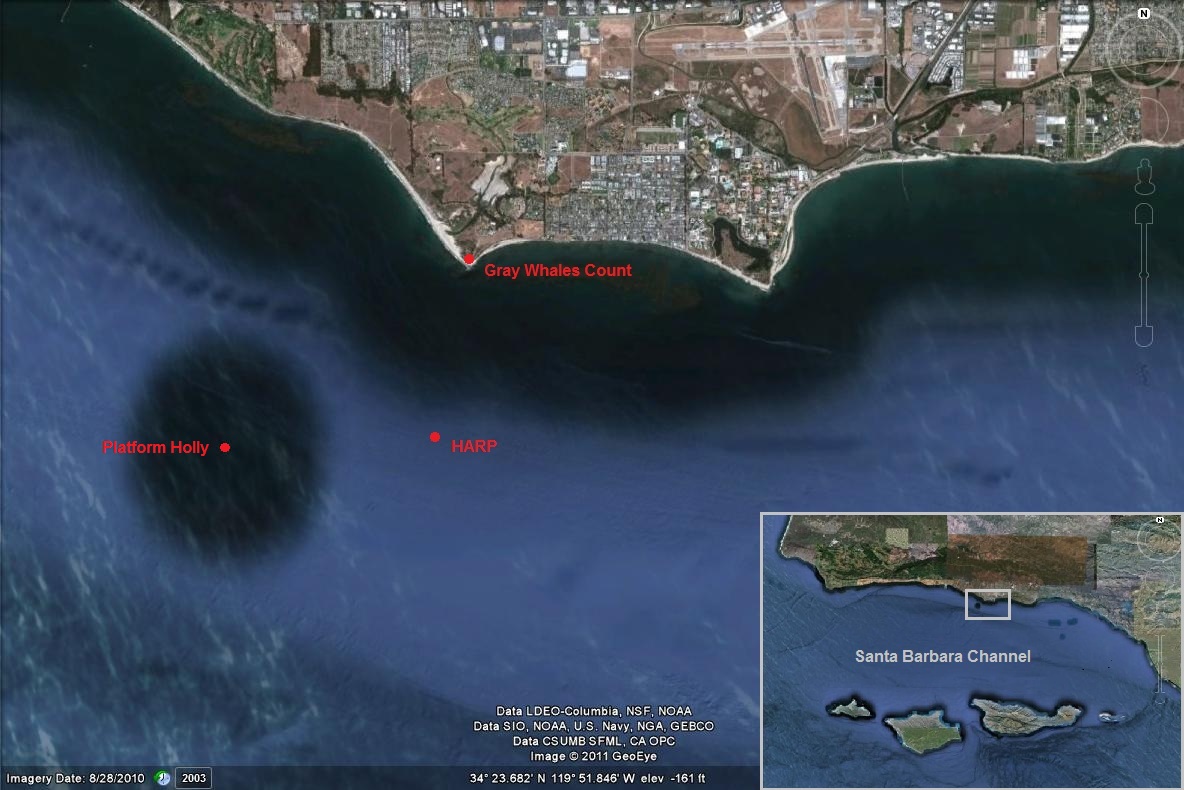
Lauren Roche – lroche@ucsd.edu
Ana Širovic – asirovic@ucsd.edu
Jasmine Buccowich – jbuccowi@ucsd.edu
Sean Wiggins – swiggins@ucsd.edu
John Hildebrand – jahildebrand@ucsd.edu
Scripps Institution of Oceanography
UC San Diego
9500 Gilman Drive
La Jolla, CA 92093-0205
Michael Smith – Michael@GrayWhalesCount.org
Erin McCann – elm0917@hotmail.com
Gray Whales Count
211 W. Gutierrez Street
Suite 8
Santa Barbara, CA 93101
Popular version of paper 5aAB9
Presented Friday morning, November 4, 2011
162nd ASA Meeting, San Diego, Calif.
Visual surveys often are used to monitor baleen whale populations. However, they can be expensive, weather-dependent, and only provide information about whale behavior at the sea surface during daylight hours. Whales spend most of their lives below the sea surface and use sound to communicate and to sense their environment. Passive acoustic monitoring of whale sounds can complement visual surveys by providing subsurface details on the behavior of whales day and night, over long periods, in all weather conditions, and for relatively low cost. In 2010, we conducted concurrent visual and acoustic monitoring surveys near Coal Oil Point in the Santa Barbara Channel to provide a better understanding of the surface and acoustic behaviors of gray whales as they migrate along the California coast.
The migration of eastern North Pacific gray whales is among the longest of any mammal. On their northbound route, gray whales travel for approximately two months within ten kilometers of the coastline from Pacific lagoons on Mexico’s Baja California Sur peninsula to feeding waters offshore of northern Alaska. During this northbound migration, gray whales pass through the Santa Barbara Channel and come close to shore near Coal Oil Point, a site where Gray Whales Count has been conducting a land-based visual survey from February to May for the past seven years. In 2010, we deployed a High Frequency Recording Package (HARP) (Wiggins and Hildebrand, 2007) to about 50 meters deep on the ocean floor approximately 2 kilometers offshore from the Gray Whales Count location (Figure 1). The instrument recorded continuously for three months concurrently during most of the 2010 Gray Whales Count visual survey. This simultaneous acoustic and visual data will provide information about how gray whales are communicating on their way up to their feeding grounds, a behavior that is not well understood.
Gray whales are known to produce at least four different types of sounds while migrating (Cummings et al., 1968, Crane and Lashkari, 1996). A low frequency moan, the M3 call, is the most common call type produced by gray whales in our 2010 HARP recordings (Figure 2). In this study, we characterized the calls and matched the recorded times of these calls with the visual tracks of the whales. We found a total of 64 sightings to have corresponding gray whale calls, and of these matches, the call rate was an average of 2.2 calls per whale per hour. The visual and acoustic data were used to estimate the location of the whale producing the calls and the sound transmission loss from the whale to the HARP. We also used the matches to determine if certain types of whale groups (e.g., singular whales, cow/calf pairs, etc.) or surface behaviors could be associated with calling whales.

Figure 1. Map of study area.

Figure 2. Spectrogram of a gray whale M3 call found in the HARP data. Color denotes sound intensity, red being highest amplitude.
Click here to listen to this gray whale M3 call.
References:
Wiggins, S.M. and J.A. Hildebrand. High-frequency Acoustic Recording Package (HARP) for broad-band, long-term marine mammal monitoring. Pages 551-557, International Symposium on Underwater Technology 2007 and International Workshop on Scientific Use of Submarine Cables & Related Technologies 2007. Institute of Electrical and Electronics Engineers, Tokyo, Japan. 2007.
Cummings, W. C., Thompson, P. O., & Cook, R. (1968). Underwater Sounds of Migrating Gray Whales, Eschrichtius glaucus (Cope). Journal of the Acoustical Society of America, 44(5), 1278-81.
Crane, N. C. & Lashkari, K. (1996). Sound production of gray whales, Eschrichtius robustus, along their migration route: a new approach to signal analysis. Journal of the Acoustical Society of America. 100(3), 1878-86.